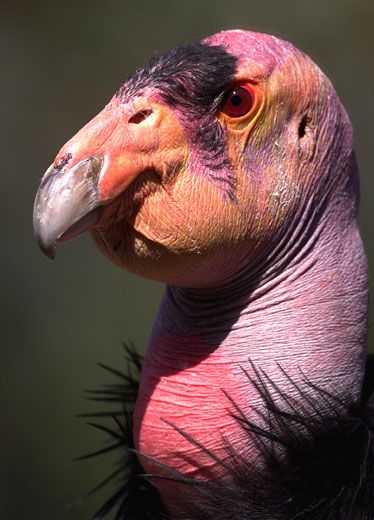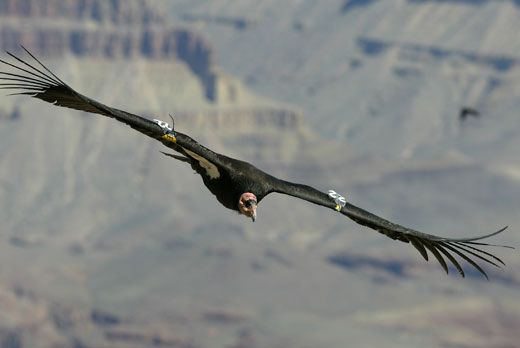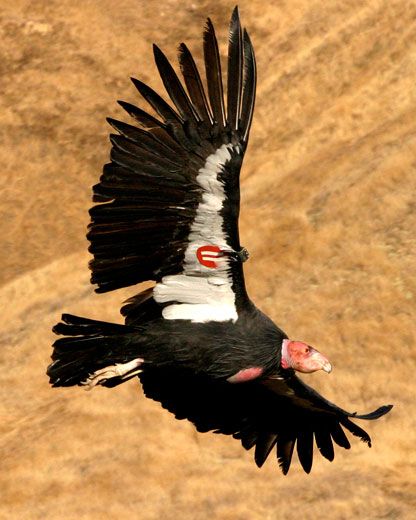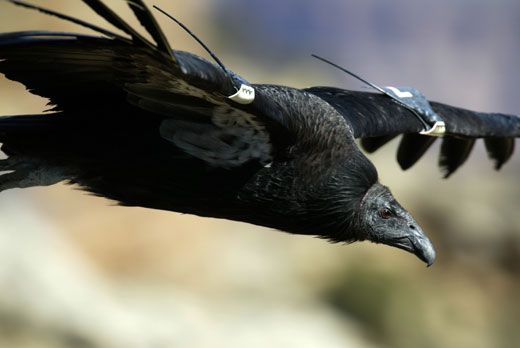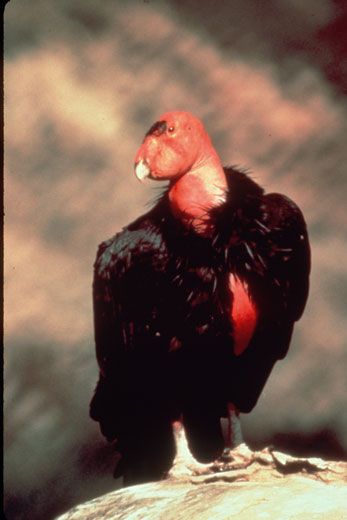Condors in a Coal Mine
California’s lead bullet ban protects condors and other wildlife, but its biggest beneficiaries may be humans
/https://tf-cmsv2-smithsonianmag-media.s3.amazonaws.com/filer/califcondor_631-2.jpg)
It was early winter, the end of deer-hunting season in Central California, and condor biologist Joe Burnett of the Ventana Wildlife Society was steeling himself for a task he had come to dread. Burnett and a team of four Condor Recovery Program members were at a remote site in the mountains east of Big Sur, where they were trapping condors and testing them for lead poisoning.
Three team members were restraining an adult female known as Condor 208. Their arms encircled her body, and one person clamped the bird's powerful jaws shut. Burnett grabbed a syringe.
"OK, here we go," he said. The team members tightened their hold, and Burnett plunged the needle into the bird's leg. The condor flinched.
Burnett transferred a drop of blood to a glass slide and inserted it into a portable instrument that tests blood for lead. It takes the instrument three minutes to give a reading; Burnett calls the waiting time "180 seconds from hell." An eerie silence enveloped the group as they awaited a prognosis on the bird's fate.
The machine beeped and displayed the test result: High. The bird's blood-lead level was elevated beyond the instrument's range. Condor 208 was in mortal danger.
The team rushed Condor 208 to the Los Angeles Zoo, where more sophisticated tests showed her blood-lead level to be more than ten times higher than acceptable. Veterinarians confined Condor 208 in a small pen and started twice-daily injections of a chelating agent to flush the lead from her body. It was the beginning of a desperate, round-the-clock attempt to save her life.
Prior to the gold rush, the California condor's population had been stable for thousands of years. The birds, with nine-and-a-half-foot wingspans, soared over much of the West. But beginning in the mid-1800s, a massive influx of new settlers upended the region's ecology and the condor began to plunge toward extinction. Shooting, egg collecting and especially poisoning from lead bullet fragments in hunter-shot game depleted the species' population. By 1982, only 22 condors remained.
Alarmed that our nation's largest bird was on its way to becoming a museum relic, a team of scientists embarked on one of the most controversial and high-profile recovery programs in conservation history. They captured every condor in the wild and established a captive-breeding program. The Condor Recovery Program has since increased the condor's population to its current level of more than 300 birds. About 150 of these condors have been released to fly free in California, Arizona, Utah and Baja California.
Lead poisoning was the main reason for the condor's decline, and lead remains the primary obstacle to the bird's recovery. Hunting season is a particularly perilous time; the number of lead-poisoning incidents spikes when condors eat game that has been shot but not retrieved by hunters.
Lead bullet fragments were first shown to be killing condors in 1984. As the years passed and evidence accumulated documenting the harm caused by spent ammunition, condor biologists determined that if they could not solve the lead bullet issue, the bird's future was hopeless.
Advocates for banning lead bullets point out that alternatives such as solid copper bullets are considered some of the best ammunition available. A simple switch to other ammunition would stop the dispersal of thousands of tons of lead across our landscape each year. At the same time, it would preserve the sport of hunting, which provides a significant food source for condors.
Some gun groups—including the National Rifle Association—have lobbied against any restrictions on lead ammunition. They object to the higher cost of alternative ammunition and say the research linking poisoned condors to lead bullet fragments is not definitive. Many opponents view attempts to regulate lead ammunition as an attack on their right to hunt. For more than two decades, their fierce opposition prevented the enactment of legislation to curtail the use of toxic lead bullets.
Last year, in one of the most significant developments in condor conservation history, California legislators passed a bill restricting lead bullets. Despite intense lobbying by gun organizations, Gov. Arnold Schwarzenegger signed legislation that requires the use of nonlead ammunition for big game hunting in much of California. The ban went into effect in July.
"The lead bullet ban is a huge step forward and gives the condor a real chance for recovery," said Kelly Sorenson, executive director of the Ventana Wildlife Society. "But there are only a few game wardens to enforce this law. Its success will depend on hunters understanding that lead is deadly."
California's new lead bullet ban was designed to protect condors and other wildlife. But while the ban was being debated, intriguing new research was emerging to suggest that the biggest beneficiaries may be humans.
In 2007, the condor's lead-poisoning problems caught the attention of William Cornatzer, a physician in Bismarck, North Dakota, who had joined the board of directors of the Peregrine Fund, a group that manages condor releases near the Grand Canyon.
An avid hunter, Cornatzer was intrigued by studies demonstrating what happens to a lead bullet when it hits a game animal. Condor biologists had shown that the bullet shatters into dozens and sometimes hundreds of tiny fragments that scatter widely from the wound site, leaving behind a deadly "snowstorm" of toxic lead that poisons condors and other scavengers such as ravens and bald eagles. Audubon California, an environmental conservation group, has identified 48 birds and other animals that are harmed by spent ammunition. Cornatzer wondered if humans might also be at risk.
Early in 2008, Cornatzer contacted the North Dakota Department of Health and arranged to collect 100 one-pound packages of ground venison donated by hunters to North Dakota food pantries. A radiologist helped Cornatzer run CT scans on the packages. They were stunned to discover that 59 of them contained metal fragments.
"The scans just lit up with tiny bits of metal," Cornatzer said. "I almost fell over. I could not believe how much metal was in the meat."
The North Dakota Department of Health ran additional scans that showed the metal fragments tested strongly for lead. Concerned about the potential risks for humans, North Dakota officials recommended the destruction of tons of venison still in storage at food pantries.
Spurred by the North Dakota findings, health departments in several other states ran similar tests and also found tainted meat. In the largest survey of donated venison, Minnesota officials X-rayed 1,239 packages and found 22 percent to be contaminated with lead.
"The lead fragments are so small that you can't feel them in your mouth when you are eating venison burger or sausage," Cornatzer said.
Because of the possible consequences for humans, North Dakota's Department of Health and the U.S. Centers for Disease Control and Prevention (CDC) are currently analyzing the blood-lead levels of 740 North Dakotans. The study participants were asked about possible sources of lead exposure—including game. The complete results are expected sometime next year. Chinaro Kennedy, a CDC epidemiologist leading the study, says "the number one thing people need to be aware of is the potential risk from lead—even in small doses."
The symptoms of low-level lead poisoning are insidious, ranging from hearing loss and high blood pressure to cardiovascular disease, stroke and kidney damage. Young children exposed to lead can suffer permanent intellectual impairment. In 2006, research conducted at Tulane University showed that blood-lead levels that were once thought safe are linked to a higher risk of death from a range of causes.
In May 2008, the Peregrine Fund sponsored a conference that brought together for the first time wildlife biologists and human health experts to examine the implications of ingesting spent lead ammunition.
"The overwhelming message from the conference was that people just haven't thought about the possibility that lead bullet fragments could be a source of sub-lethal human poisoning," said Rick Watson, vice president of the Peregrine Fund.
Calls have already begun for a nationwide ban on lead ammunition. The Humane Society of the United States, as well as a 2008 California Condor Blue Ribbon Panel sponsored by the American Ornithologists' Union and Audubon California, have recommended that hunters everywhere switch to alternative ammunition.
Condor 208 barely survived her massive lead poisoning. After she endured five stressful weeks of rehabilitation at the Los Angeles Zoo, veterinarians released her back into the chaparral-covered mountains near Big Sur. Then, in the spring of 2007, Condor 208 and a mate nested in a remote sandstone cliff, and she gave birth to the first condor chick born in Central California in more than 100 years. The baby condor was named Centennia.
Because the ban on lead ammunition is so new, Joe Burnett still has to test condors for lead poisoning. But he is hopeful that someday he can dispense with his syringe and field blood lab. For the first time in decades, the condor's prospects look brighter.
Additional research will be needed to investigate more fully the potential human health risks of ingesting lead from hunter-shot game. In the meantime, across the country most hunters continue to use lead bullets to shoot the game they bring home for their families to eat. Many of them are unaware of the hidden danger that could lurk in their meat.
Like canaries in a coal mine, the condors are acting as sentinels, providing a warning for anyone eating hunter-shot game. This ancient bird is telling us to pay attention—and to be careful.
John Moir is an award-winning science journalist and author of Return of the Condor: The Race to Save Our Largest Bird from Extinction.
